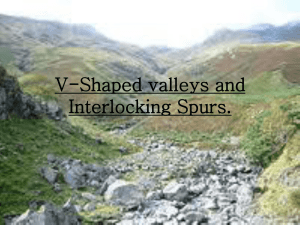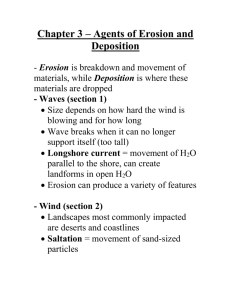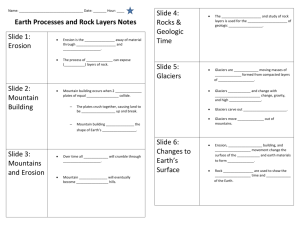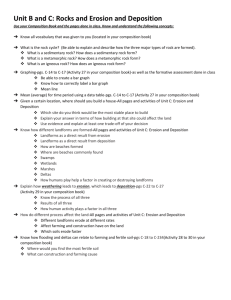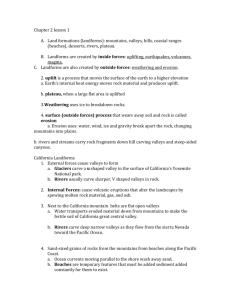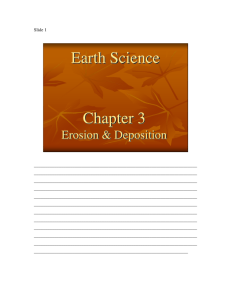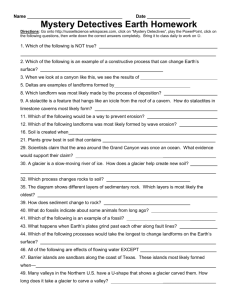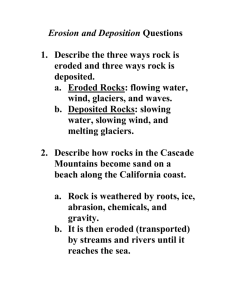Notes version
advertisement
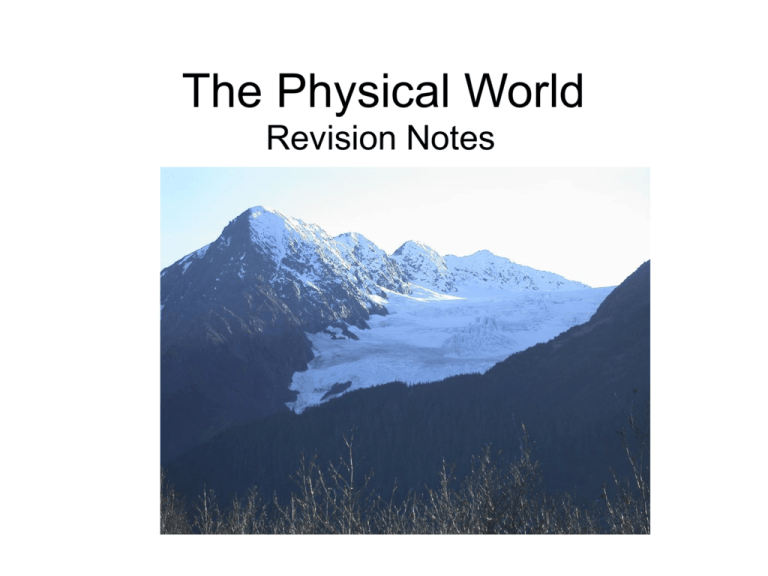
The Physical World Revision Notes The Physical World • This unit is all about Rivers, Coasts and Glaciers and how these physical entities change the land on which we live over thousands of years. • In particular, you will need to know in detail how various land forms are created, and the processes that help to create the landforms. • A Landform is a particular shape of the land resulting from thousands of years of change. • A process is a continuing force that can change the natural world. Rivers – How they change from source to mouth • • • • • Rivers change immensely on their journey from Source areas (where they start) to their finishing point at their mouths. Velocity increases as more water is added to rivers via tributary rivers. This means that less of the water is in contact with the bed of the river and the mouth so there is less energy used to overcome friction. Hence rivers flow progressively faster on their journey downstream. Width and depth increases as more water is added from tributaries. Gradient (the slope of the land) decreases as rivers flow because the river meanders across the land rather than erode into it and follow a straight path as it does in the source. This means it covers a decrease in height over a longer distance the further downstream you get. Stone size decreases downstream and the stones get rounder and smoother as rivers erode the rocks progressively as the stones are transported downstream. Rivers – How they change from source to mouth • • Watershed Interlocking spur • A diagram of the drainage basin • The diagram on the right shows the major changes downstream. In the source area the drainage basin (an area of land drained by a river and its tributaries) contains V shaped valleys and waterfalls, and the dominant processes are erosional. Erosion tends to be vertical (straight down into the land). In the middle section of the drainage basin the river starts to erode laterally. This section contains meanders and Ox bow lakes, and the river creates a flood plain often with Levees. Here, Material is deposited and erosion can also occur. In the lower drainage basin deposition dominates as a river enters a sea or lake, the valley is at its widest and deltas and estuaries are major landforms and habitats. Landforms in upper River Valleys Waterfalls • • • • • • • • Waterfalls are created by erosion processes. They occur where a band of hard rock (e.g. granite) overlies a softer rock (e.g. sandstone). Erosion processes such as Hydraulic Action (the force of the water) and Abrasion (where the river rubs stones that are being transported against the bed of a river thereby breaking it down) dominate. The softer rock is eroded quicker than the harder rock. This creates a plunge pool where water is swilled around. Over time, the softer rock is eroded further creating an over hang of hard rock. Eventually, this hard rock collapses because it is unsupported and the waterfall moves back upstream. This creates Gorges, steep sided deep river valleys. Landforms in upper River Valleys – V-shaped valleys • Vertical erosion processes wear away the rock in upper valleys. • As the river erodes down over it leaves behind valley sides that are shaped like a letter V • The result is that the river valley contains interlocking spurs, slivers of land that interlock. Interlocking spurs are areas of more resistant rock left behind because the river erodes softer rock quicker. The river moves between the interlocking spurs. Landforms in the middle valley – Meanders and Ox-bow lakes • • • • • • • Meanders occur in the middle valley and are the result of erosion AND deposition processes on a river. In this section of the valley the river erodes laterally and migrates across the valley floor over time, widening the valley. Within the river itself, the fastest current is found on the outside of a bend and the slowest current on the inside of the bend. This is because the depth of the water on the outside of the bend is deeper, so there is less friction and hence higher velocities. Over time, this means that erosion occurs on the outside of meanders bends and deposition occurs on the inside. In the diagrams, erosion of the outside of the meander means that the neck of land becomes narrower and narrower over time. On the inside of the bend the slow flow encourages the deposition of beaches. After a long time the neck of land gets totally cut through by erosion processes such as hydraulic action and abrasion. This cuts off the meander bend which is totally isolated by deposition leaving an Ox bow lake Landforms in the middle valley – Floodplains and Levees • • • • • • Rivers flood on a regular basis. When rivers flood in the middle valley the cover an area of land known as the flood plain. When they flood velocity is slowed and deposition of any rocks being transported is encouraged. This deposition leaves a layer of sediment across the whole floodplain. After several floods there are several layers of sediment (rocks) deep on the flood plain. In addition, the largest rocks and most deposition occurs next to the river channel. This leaves a ridge of higher material next to the river channel on both banks of the river known as a levee. Landforms in the lower valley – Estuaries and Deltas • Deposition dominates in the lower valley as river velocity falls as it enters a sea or lake. • This results in deposition of fine sediments such as silt and clay. • This sediment can build up over time forming estuaries and deltas. • Deltas have distributaries where the river channel splits up into smaller rivers on its journey to the sea. • Birds foot deltas are comprised of fine sediments like silt and a good example is the Mississippi delta seen on the top photograph. • Arcuate deltas are composed of coarser sands and gravels and can be seen on the river Nile on the bottom photograph. What are Glaciers? • • • Glaciers are large sheets of ice that sit on the surface of the land. How do glaciers form? Glaciers form in regions where there is enough snow fall. Over several years when enough snow accumulates the snow is compacted into ice. This happens because the weight of the snow on the top layers forces the air out of the snow in the bottom\layers closest to the rock surface. Why do glaciers form? Glaciers form where ever temperature is low enough to allow permanent ice and snow cover that doesn’t all melt over summer. High latitudes (e.g The polar regions) and areas of high altitude (e.g. Mountains) are the best places to find glaciers. North facing slopes, that receive less sunlight due to the angle that the sun hits the Earth, also get glaciers. How do Glaciers Move? There are 4 factors responsible for glacier movement; • Weight (Mass) – Glaciers can be huge, kilometres long and hundreds of meters deep. They therefore weigh a lot. • Slope – Glaciers that occur in mountainous areas are found on steep slopes, this allows quicker movement. • Gravity -this is the force responsible for pulling these huge slabs of ice down the mountainside. • Water at the base helps to allow some glaciers to move How do glaciers erode? • Plucking • First, ice has the property of being able to freeze to rock. The glacier uses this to adhere to part of the ground. Then, as the glacier forces the ice frozen to the ground to continue moving down slope, the rock may be pulled out of the ground and moved down slope as well. How do Glaciers erode? • Abrasion • Second, once glaciers have rock and sediment at their bases they can push this sediment against the ground and use it like sandpaper. This abrasion of rock against rock can scour the landscape and leave large gouges, small striations, or even a finely polished surface. How Corries Form • Corries form in hollows where snow can accumulate. The snow compacts into ice. This moves down hill, plucking and abrading the hollow. This creates a steep back wall and a hollow known as a corrie or cirque. When the ice melts a corrie lake forms. How Corries form Landforms Created by Glaciers. U – Shaped Valleys. These are steep sided, wide valleys in the shape of the letter U. They are formed by a valley glacier that moves down the valley because of gravity. As the glacier moves down the valley it plucks the rock from beneath and those rocks then rub against the bed of the valley, eroding it further. This deepens and widens the valley. Glacial Landforms • Truncated Spurs. • These are interlocking spurs without the land that interlocks! • As a river erodes the upper valley it cuts down into the rock and meanders in and out of the surrounding rock. • When glaciers form as the temperature decreases they move down the valley. • As the glacier moves it plucks the rock from the floor and it abrades the valley sides and floor. • At the front edge of the glacier material is bulldozed forward. • The end result is that the interlocking spurs are eroded, creating truncated (cut off) spurs. Glacial Landforms Ribbon Lakes. These are Long and thin lakes that form after the glacier has melted. During glaciation the glacier erodes some parts of the valley floor more than others. When the glacier melts water fills the depressions (holes) where the valley floor was eroded most. Hanging Valleys These are the valleys of tributary (smaller) glaciers that are left high above the floor of the main glacier. You often get waterfalls here. The Changes Glaciers make to River Valleys River Valleys Have interlocking spurs The river has less erosion power than a glacier Are V shaped During Glaciation Ice occupies the valley floor Interlocking spurs are eroded Plucking and Abrasion occurs After Glaciation Ribbon lakes, truncated spurs, Hanging valleys and shaped valleys are left. Additional Diagrams The coastal system • Coasts are dynamic environments that have inputs of sediment and losses of sediment. • The major processes are; • Erosion- Hydraulic action, corrosion, abrasion, attrition. • Weathering – Chemical, biological and physical. Coastal Landforms - Erosion • • • • • Cliffs retreat inland as a result of erosion processes. Waves pound the base of cliffs, hydraulic action (the sheer force of the water) and abrasion (rocks hurled against the base of the cliff) erode a wave cut notch. Eventually, the material on the cliff face, weakened by weathering, collapses because it is unsupported. This material is washed away by the sea and the cliff retreats in land. This may leave a very flat smooth area of rock in front of the cliff known as a wave cut platform. Coastal Landforms - Erosion Stacks • Stacks, stumps and caves are formed on cliffs. • Waves attack vertical lines of weakness in the rock known as Faults. • Processes such as hydraulic action and abrasion widen the cracks into caves. • Over time, the cave will be eroded into an arch, accessible to the sea on both sides. Finally, the erosion continues and the arch collapses leaving behind a stack (a vertical column of rock) Coastal Landforms - Erosion • • Softer rock Harder Rock • • Coves and bays form where rock runs in bands horizontal to the direction of wave attack. There is a band of resistant rock closest to the sea and a band of less resistant rock inland. The waves seek out faults in the hard rock and erode through to the soft rock. Wave processes erode the softer rock faster and this leaves a circular cove with a narrow entrance where the sea enters. A good example of this is Lulworth cove. Which can be seen opposite. Lulworth Cove Coastal landforms - Deposition • Beaches are formed by wave processes. • Gently sloping beaches are formed by strong destructive waves that backwash more material away from the beach that they swash up the beach. • Steeply sloping beaches occur by constructive waves that swash more material up the beach than they backwash away, building up a steep beach gradient. Coastal Landforms -Deposition • • • • • Spits are created by the process of Long shore drift. Material is carried along the shore in a zigzag fashion by waves as they swash material up the beach at an angle and backwash material down the beach at a right angle. Wherever there is a break in the coastline (e.g. across a river or a change in coastline direction) then material is deposited closest to the shore. Eventually this material builds up out into sea to form a spit. As seen in the picture opposite of Spurn Head Spits often have salt marshes build up behind them.
